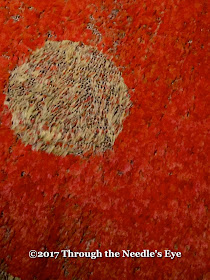Since arriving in Germany this past June, I (Kara) have jumped into a number of quilt guilds and groups. One group that I have joined is called the Baltimore Beauties. Many of the ladies there were once a part of a group that made a Baltimore Album quilt based on Mimi Dietrich's patterns; thus the name. The group has stuck together and now meets monthly to quilt, knit, or just to help develop their skills in English or German. Most of the ladies are German, but the love of quilting overcomes any language barriers. Their English is hands-down, way better than my German, and they graciously correct my inept pronunciations. Their willingness to teach even extends to cooking, as one of the ladies is going to teach a few of us how to make spaetzle, the traditional Swabian way.
 |
| Spaetzle: A staple around here. Click here for the recipe |
On my very first visit to this group, Daniela, the organizer, mentioned that one of the local museums in Stuttgart was going to be presenting an exhibit about Hawaii. Somehow the idea of a sew-in of Hawaiian quilts was brought up, and our group was asked to stitch Hawaiian quilt blocks at the museum. Many agreed to participate, so for the next few months, we prepped and started our blocks. I purchased a few books with patterns; Amazon had a great deal on three books which I rationalized gave me more blocks to choose from! I chose to back-baste my block instead of constructing it in the traditional, Hawaiian way and found that it was the perfect method for this style of appliqué.
 |
| Three for $20! How could I pass it up? |
 |
| The front. |
 |
| The back. |
 |
| A quarter of the way finished |
As you can see, I haven't finished my block yet, but I needed something to stitch on for the sew-in (that's my excuse and I'm sticking with it). I forgot how much I enjoyed needle-turning batik fabric. Unfortunately, that block has been relegated down on the priority list, but I will finish it.
 |
| At the exhibit entrance. |
Our sew-in day was November 29, and before we sat down to stitch, we were able to get a private tour with the curator of the exhibit. The items in the exhibit were gathered from all parts of the world, and surprisingly, most of the collections came from other European countries.
 |
| The curator explaining how this particular textile was made. |
The focus of the exhibit was about the tumultuous history of Hawaii and its colonization, so there was only one quilt in the exhibit; not in the traditional style, but made to share a political opinion. Of course, I was most interested in the textiles, so that is primarily what I will show you here.
 |
| A quilt made about the British rule. |
 |
| A traditional kapa cloth made of bark fibers |
 |
| Kapa cloth detail |
 |
Most kapa cloth was used for clothing; the plain for the common man
and the patterned for the high-ranking families. |
 |
| Kapa was also used for blankets. |
 |
Kapa was traditionally made by women using the fibres
of the wauke or Paper Mulberry. |
 |
Since the 1980s, the forgotten tradition of making kapa
has been revived as a part of Hawaiian, textile. artistry. |
Other textiles in this exhibit involved feathers—and a lot of them! The feathered cloaks and headdresses were considered sacred and worn as symbols of power.
a |
| All made of feathers attached to a web-like structure. |
 |
| A close up of the feathers. |
 |
| More feathered detail |
 |
This feathered cloak and helmet were designed to protect the head and spine,
which were thought to be sacred. |
 |
| Helmet detail |
 |
| "My! What big teeth you have!" |
After our tour of these amazing artifacts, it was our turn to sit and stitch. We had quite a few visitors stop by to watch us as we needle-turned our blocks. A couple of our ladies had already finished their blocks and were beginning to quilt them.
 |
German and American quilters stitching Hawaiian appliqué!
You can't make this stuff up! |
 |
| Beautiful, bright, tropical, colors! |
We all had such a lovely time, and it was a wonderful opportunity on so many levels. It was so kind of the museum to invite us to share our appliqué passion with the museum goers. Have you tried Hawaiian appliqué? If so, we'd love to hear about your experience.
Until next time, Aloha!






















No comments:
Post a Comment